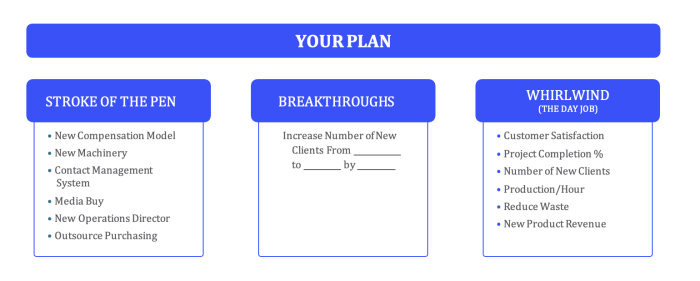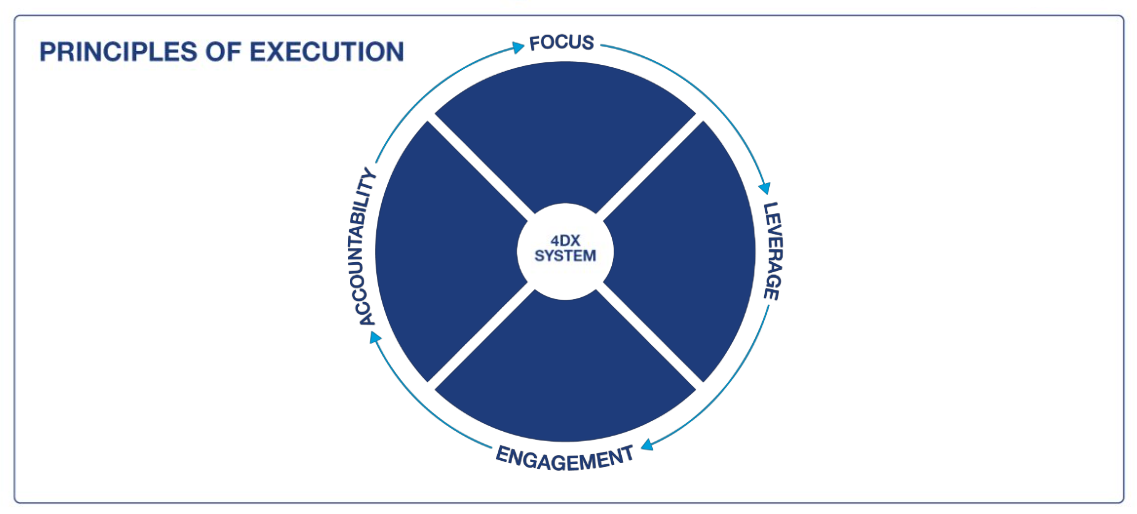Strategic Execution in Uncertainty and Complexity

People can only handle so much ambiguity.
It’s a bit like carbon monoxide poisoning: It doesn’t matter if we’re getting a little poisoned at the office or a little at home—the human body can only take so much before it crumbles.
Over the last five years, many of us have experienced “ambiguity poisoning” in many aspects of life. But we can lower the ambiguity threshold by saying, “We know the one thing we’re going to do right now. We’re going to break this goal down into targets. Everyone’s going to try to move a lead measure. We’re going to track our progress on a scoreboard, and we’re going to attack it every week.”
But more commonly during periods of ambiguity and uncertainty, people go to one of two places: 1) they either bury their heads in maintaining the day job and retreat to tasks that seem familiar, controllable, or comfortable, or 2) they become distressed and distracted by everything outside their control, such as checking the news, conferring with colleagues, and hypothesizing.
While those reactions are understandable, neither will help an organization proactively fight through disruption.
Executing strategic priorities is always about maintaining focus amid distraction and complexity. Under normal circumstances, everything inside the organization wants to dilute the focus. But once you’re dealing with disruption and uncertainty, distraction and complexity skyrocket, and a person’s ability to maintain focus becomes that much more difficult. Focus is more critical than ever, and it’s harder than ever to focus.
Leaders must understand that their teams are probably dealing with a lot of uncertainty—and people have minimal ability to handle it. We can manage our day jobs; they come at us fast, but at least we know how to deal with them. But new goals, strategies, and priorities represent disruption to the status quo. We don’t know how we’re going to accomplish them. Putting too many goals on team members can cause them to become paralyzed or retreat to the day job.
More than ever, leaders need to clarify the one goal their team should focus on accomplishing. We have a million things we can—and must— work on at any given moment. To determine the one thing our teams should be laser-focused on, let’s start by reducing complexity.
Discover why performance stalls during uncertainty—and how to get it moving by aligning your teams with a clear strategic vision and focused execution.
Avoid the Complexity Trap
Execution thrives with simplicity and transparency.
Execution doesn’t like complexity. As complexity increases, it becomes more and more difficult to maintain focus. But the 3,000 leaders we’ve worked with over the last 30+ years all seem to say the same two things, now more than ever:
- We have to narrow our focus.
- I have 20 or more things that need my immediate attention right now.
These statements both feel true, and they don’t get along. Everybody knows this feeling: I’m missing a critical project deadline. Two people were supposed to be hired last month, but I don’t know if hiring has been frozen. I have to report to the GM at the end of the day about two emergency initiatives, and a KPI just took a nosedive.
And in the middle of that conflict, we know the one thing that would have the most significant impact on the operation isn’t getting our attention. And if that top priority isn’t getting our attention, it’s probably not getting our team’s attention.
If we can view our priorities through the lens of how those priorities will be executed, we can start to remove a lot of unnecessary complexity.
Sort Everything Into Three
Think about the major aspects of your plan or strategy. We’re going to divide those elements into three columns.

We’ll call the first column, “Stroke of the Pen.” These elements require either money or leadership authority to happen—for instance, changing the compensation system, purchasing new machinery, changing an existing procedure, making a media buy, or hiring a new staff member. These actions typically have a significant impact, and we have a fair amount of control over them.
The middle column is for “Breakthroughs.” These are vitally important goals that are at considerable risk of not being achieved. We refer to them as “Wildly Important Goals®” or WIGs®—and although they usually originate from those other two columns, they can’t be achieved in those columns. Breakthroughs can’t be realized with the stroke of a pen. You can’t mandate them, and you can’t buy them (if you could, you would have already). Breakthroughs won’t happen through your existing processes either. They won’t happen unless the organization starts working differently. They almost always require a change in behavior and a high degree of human engagement.
We’ll call the final column the “Whirlwind.” Think: day job. This column contains the critical standards that must be met to sustain current operations. People often call these key performance indicators or KPIs; they include things like customer satisfaction scores, project completion percentage, new clients, production metrics, or revenue numbers. This column is maintained by existing processes and by a great deal of firefighting.
Focus on the Middle Column
To identify a breakthrough, start by asking yourself this question: In your mind, what lives at the intersection of really important and not going to happen (unless you do something very different)?
Keep in mind that this breakthrough is not always the most important objective overall; it’s the most important objective that probably isn’t going to happen without dedicated focus. By definition, breakthroughs require us to close a gap.
Breakthroughs are more resistant to direct management influence. They tend to require commitment more than compliance. Leaders have a fair amount of control over the Stroke of the Pen and the existing processes in the Whirlwind. In those columns, you can often get away with compliance.
Think of each of these columns as requiring a different execution treatment. Leaders can be strong in one column and struggle in another.
In our experience, the greatest frustration and the most complexity are experienced in the conflict between the breakthrough and the whirlwind. These efforts do not get along. They compete for time, energy, and attention. And in most organizations, the urgency and the intense distraction associated with the whirlwind dominate the strategic importance of any breakthrough.
Here is the critical, brutal truth to understand to keep from drowning in complexity: The whirlwind is going to eat up 80% of your organization’s energy before you get any traction on a breakthrough requiring a change in human behavior.
This is a hard truth because, no matter how necessary or how compelling our breakthrough strategy is in the moment, it will never feel as urgent to everyone as the whirlwind—the day job. This is even more true during times of crisis, when people want to flee to the comfort of what they know.
No leader gets a pass on this. No leader gets to paint on a blank canvas. After all, 80% of that canvas has already been painted on.
Quite possibly, the most important strategic question that any leader answers is, “How will I spend that 20%?” It doesn’t take long to realize that if you spread that 20% out across too many breakthroughs at the same time, you paralyze the organization.
The 4 Disciplines of Execution® is nothing more than a process for applying that sacred 20% of your energy toward executing the breakthrough goals. This framework is used by leaders and leadership teams to execute critical goals while staying out of the complexity trap.
Are you spending your energy on the right efforts? Download our free 80/20 Activity Analyzer tool to learn which activities will have the biggest impact on results.
The Most Trusted Leadership Company
Learn how your organization can use our people, content, and technology to create collective action and meaningful change.

Apply the 4 Disciplines of Execution to Your Breakthroughs
The 4 Disciplines help a leader create a winnable game, empowering you to execute your most important goals in the face of competing priorities and distractions. The disciplines are powerful, yet simple. But they can be tricky to apply and sustain because they require us to work differently than we normally do.
Let’s discuss how leaders can implement each discipline, as well as essential nuances that will help you apply these disciplines during a crisis.

Discipline 1: Focus on the Wildly Important
Focusing on the wildly important requires you to focus on less to accomplish more. Start by selecting one Wildly Important Goal® (WIG®) from your breakthrough column instead of trying to work on a dozen goals all at once. We’re not suggesting you ignore the whirlwind or the work necessary to maintain your operation. We are suggesting you apply a different treatment to your WIG.
To define a WIG, identify where you are now, where you want to be, and by when. Said differently, define a starting line, a finish line, and a deadline—expressed as “From X to Y by When.”
Psychologically, it’s very important to have a single measure of success. This is the discipline of focus, and it’s the first step to creating a winnable game.
Applying Discipline 1 Amid Uncertainty
Many goals are actually a concept masquerading as a goal. These concepts often create an illusion of clarity for the person who’s doing the talking and setting the direction.
But in actuality, the concept can go in any direction. For example, when leaders at NASA first said they wanted to lead the world in space exploration, it might be easy to think, What else do you need to know? Just beat the Russians! But that concept could mean a million different things to each team and employee. Then, John F. Kennedy set the goal to put a man on the moon by the end of the decade and return him safely home. He set a clear goal with a starting line, a finish line, and a deadline.
Discipline 1 is always a challenge, but amidst uncertainty and change, leaders often hesitate to draw a line in the sand because they’re dealing with so many unknown variables: Well, I can’t say when, because we don’t know what’s going to happen. We don’t know if we’re going to get the resources. We don’t even know if we’re going to be open in two weeks. The higher the ambiguity, the less likely leaders are to draw a line in the sand—but that’s exactly what they have to do. The hardest time to focus on the wildly important is during times of uncertainty, and that’s when it’s most necessary.
If circumstances change in the future, you’ll adapt. But still recognize that despite the intense amount of uncertainty, you must create a starting line, a finish line, and a deadline. Clarity is the first step toward creating focus.
And it’s not enough that the organization does this. Each team needs to define their Wildly Important Goal. Every team needs to know, in addition to the day job, all this stuff we have to do just to survive—what’s the one result that we are going to stay focused on amidst distractions to help achieve the organization’s WIGs?
Not sure which priorities should receive special focus? Download our free workbook, 4 Steps to Refine and Execute Your Team Goals, to get clear on and achieve top imperatives.
Discipline 2: Act on the Lead Measures
No matter what we’re trying to achieve, our success will be based on two kinds of measures: lag and lead.
Lag measures track the success of our Wildly Important Goal. Lags are our results: revenue, profit, quality, and customer satisfaction. They’re called “lags” because, by the time we see them, the performance that drove them has already passed. We can’t do anything to fix them at that point. They’re history.
In contrast, lead measures track the critical activities that drive or lead to the lag measure. They predict the success of the lag measure and are influenced directly by the team.
Simple enough, but be careful. Even the smartest people fall into the trap of fixating on a lag measure they can’t directly influence, especially because lags are easier to measure. In our personal lives, a common lag measure is weight loss. Which activities or lead measures will lead to weight loss? Diet and exercise. Proper diet and exercise predict the success of weight loss, and they’re activities we can directly influence right now.
Applying Discipline 2 Amid Uncertainty
Think of a Wildly Important Goal as a boulder, and a lead measure as the lever (like a steel beam, 2×4, etc.) that moves it. We can’t influence the boulder on our own—it’s too heavy. But we can influence the lever. And when we influence the lever, the lever moves the rock.
In times of uncertainty, it’s so important that we can win at something—that we have some degree of control over some important result. Even if 80% of the rest of our lives feels like chaos, we can stay grounded if we’re making progress on one critical thing. And lead measures, when done right, give us the ability to see progress much faster than lag measures can.
I like relating this to raising teenagers. For parents, it seems we can never do enough to alleviate the storm of drama in a teenager’s life. What we can do is help that child have one thing in their life they’re winning at, despite everything else. Apply that same principle to our current situation: We can’t make the uncertainty go away, but we can give our teams one meaningful thing they can win at.
Discipline 3: Keep a Compelling Scoreboard
People play differently when they’re keeping score. If you doubt this, watch a group of kids playing basketball. See how the game changes the minute scorekeeping begins—it’s not a subtle change. Similarly, the lag and lead measures we create in Discipline 2 won’t have much meaning to the team unless they can see progress in real time.
Discipline 3 is the discipline of engagement. People perform best when they are emotionally engaged, and the highest level of engagement comes when people know the score—whether they are winning or losing the game. It’s that simple.
The best scoreboard is designed for, and often by, the players. A player’s scoreboard is quite different from the complex scoreboard coaches love to make. If players know the score, if they can influence the lead measure, and if the lead measure moves the lag measures, then they know they have a winnable game.
Applying Discipline 3 Amid Uncertainty
Remember that it’s not a winnable game if you stop after Discipline 2—it’s only a winnable hypothesis. We might have a great idea, but there’s something about human psychology that requires a scoreboard to go live to attract people’s focus and energy. It’s not a game until we keep score. And we can keep our teams focused on the game—and not on the distractions around them—with a compelling scoreboard.
Amplify engagement and motivation to drive results when you download our free guide, 8 Ways to Boost Your Team’s Commitment to Goals.
Discipline 4: Create a Cadence of Accountability
Discipline 4 is how we play that game. The cadence of accountability is a rhythm of regular and frequent team meetings that focus on the Wildly Important Goal. These meetings happen weekly, sometimes daily, and ideally last no more than 20 minutes. In that brief time, team members hold each other accountable for commitments made to move the scoreboard.
One by one, team members answer a simple question: What are the one or two most important things I can do this week that will have the biggest impact on the scoreboard?
In the meeting, each team member reports:
- If they met last week’s commitments.
- If the commitments moved the lead and lag measures on the scoreboard.
- Which commitments they will make for the upcoming week.
People are more likely to commit to their own ideas than to orders from above. And when individuals commit to their fellow team members, not only to the boss, the commitment goes beyond professional job performance to become a personal promise.
When the team sees they are having a direct impact on the Wildly Important Goal, they know they are winning. And nothing drives morale and engagement more than winning.
Applying Discipline 4 Amid Uncertainty
If we take the lever analogy one step further, now we’re creating force against the leverage. Amid all the uncertainty, all the distractions, all the desire to go back and do the day job, the WIG session forces everyone to put energy against the lever. What are the one or two things we’re going to do this week to cause the lead measure to move?
Here’s a common misconception among leaders implementing the 4 Disciplines: They think the weekly commitment is “diet and exercise,” from our earlier example. But that’s not quite right. Something will occur on a weekly basis that can hedge your bet, which will enable you to achieve the lead measure of diet and exercise. Rain is in the forecast, so I’m going to get rain gear to go running. I’m going to find a running partner. Commitments are actions that ensure we can maintain that lead-measure focus.
A lead measure is not just a metric we look at and then go back to our day job. We have to do something every week to put energy into it. Necessity is the mother of invention, and when we’re drawing these commitments from our team members, we’ll start coming up with ideas we wouldn’t have gotten any other way.
There’s another benefit, too. During the COVID-19 pandemic, one of our clients texted me this: “I am two minutes from doing my WIG session. Simply having a routine meeting weekly is helpful in this situation because there is an established routine….So grateful we had this weekly cadence established in advance.” Having that routine, that ritual, amid the chaos tends to ground everyone.
Note: Although we only refer to focus in the first discipline, each of the 4 Disciplines offers an increasingly more intense way of ratcheting up focus in an organization. Everything in an organization wants to dilute focus: Decide you’re going to focus on something, and before the day’s out, five things will try to pull you off that one thing you said that, come hell or high water, you were going to focus on. Everyone’s day job has a gravitational pull away from the organization’s breakthrough strategies—leaders have to fight that tendency. We call the first discipline “Focus on the Wildly Important,” but zeroing in on lead measures, getting a scoreboard in front of everyone, and maintaining a weekly cadence are all mechanisms of focus.
Taking the Ambiguity Out of Goal Achievement
When ambiguity increases in one part of our lives, we have less tolerance for it in another.
In his book Nonsense: The Power of Not Knowing, author Jamie Holmes shares a clever example of what happens in uncertain times. After the San Francisco earthquake of 1906, both marriage and divorce rates went up. This was not because people were drawn together or apart, but because the more dominant human dynamic was that they couldn’t handle any more uncertainty. If they’d been wavering about ending or starting a relationship, the stress and ambiguity of the crisis drove them to resolve those questions abruptly. They just couldn’t take any more ambiguity.
The 4 Disciplines of Execution take the ambiguity out of goal achievement. They create focus by lowering the uncertainty around one clear initiative:
- Focus on the Wildly Important
- Act on the Lead Measures
- Keep a Compelling Scoreboard
- Create a Cadence of Accountability
There’s a surprising byproduct of this process: increased morale. When people are facing chaos, they’ll feel a spike in engagement if there’s even one element in their life where they feel like they’re winning, and that it matters. There’s no better time to determine your Wildly Important Goal and rally your teams around it.
How can leaders make the right adjustments during uncertainty without losing momentum or focus? Learn how when you download our free guide, The Agility Advantage: 4 Steps to Respond to Change and Achieve Consistent Business Results.








